Basic watercolor techniques for beginners
Discover the world of watercolor painting with these tips and find inspiration for your next project.

Diving into watercolors.
The flowing brushstrokes and rich texture of watercolor painting are distinct in the art world. An accessible medium, watercolor paints can be used by everyone from kids to practicing artists. While many beginners start with watercolors because they’re versatile and easy to clean up, the luminous quality you can achieve with watercolors is unique, expressive, and sought after in professional settings from children’s books to portraits.
Watercolors are easy to mix and can produce a transparent wash that’s perfect for layering on paper. “There’s a dance that happens between the subtlety you can achieve with gradation in a watercolor wash and the harsh, layered outline you get when overlapping layers,” painter and illustrator Jonathan Case explains. This medium helps artists produce both delicate and bold effects.

Wet-on-wet watercolor painting.
But achieving those effects isn’t easy. Wet-on-wet painting, or using wet brushes on wet watercolor paper, can create a distinctly different look than a dry brush used on a dry surface, and mastering these effects take patience and practice. Masking tape and masking fluid can help artists control the flow or movement of water, as can the humble paper towel if they add too much water. Traditional watercolors have their limits and can be unpredictable for beginners and professionals alike. This is where digital watercolors come in.
Start to explore digital watercolor painting.
Working in a digital medium, you can achieve the look and aesthetic of traditional watercolors but with more control and precision. “Embrace what digital watercolors can do. They have qualities that are interesting and beautiful,” watercolor artist Benjamin Dewey says. Apps like Adobe Fresco let you achieve a traditional watercolor look without a drop of H2O.


Examine the opportunities and challenges of digital watercolors.
The flexibility of digital watercolor painting is a boon to professional artists. If you create an illustration for a client in traditional watercolors, it’s difficult and time consuming to edit. “The digital platform is really helpful when it comes to revisions,” explains Dewey.
Formalizing your color palette before you start a digital painting is key, as some beginners oversaturate their art with too many colors. (Understanding color theory will help you work within a pleasing, complementary color theme.) With traditional watercolors, you can overmix and overblend colors. With digital painting, neither is an issue. If your digital colors turn muddy, you’re not stuck with them — simply edit the hues.

Creating a natural, artistic brushstroke is also important in digital watercoloring. “You can’t always achieve one definitive brushstroke as easily with digital,” Case says. “You have to work for it — work to create the texture that can be accomplished more quickly with traditional media.” Experiment with layering different brushes and going over a line multiple times with your erasing tool. Like any art form, watercolors and digital painting take time and practice to master, so you have to find the approach that works for you.
Discover more watercolor painting techniques.
Traditional watercolors will always be an option, but building your mastery with digital tools can push your creative ideas even further. Whether you’re painting on paper or on a screen, start learning to harness the stunning power of watercolors now to create something new.
Contributors
Do more with Adobe Illustrator.
Create logos, icons, charts, typography, handlettering and other vector art.
You might also be interested in…
Take your skills to the next level with drawing exercises and advice from professional illustrators.
How to become a professional illustrator.
Get tips on portfolio creation and art presentation to help you kick off a new career.
Get an introduction to the illustration style of Japanese comics.
Get tips on how to draw this challenging bit of human anatomy.



